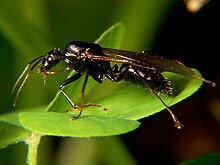This is an old revision of this page, as edited by 72.230.102.32 (talk) at 20:14, 12 December 2007 (→Species). The present address (URL) is a permanent link to this revision, which may differ significantly from the current revision.
Revision as of 20:14, 12 December 2007 by 72.230.102.32 (talk) (→Species)(diff) ← Previous revision | Latest revision (diff) | Newer revision → (diff)
| Carpenter ant | |
|---|---|

| |
| Camponotus herculeanus (Worker) | |

| |
| Camponotus pennsylvanicus (Winged Male) | |
| Scientific classification | |
| Kingdom: | Animalia |
| Phylum: | Arthropoda |
| Class: | Insecta |
| Order: | Hymenoptera |
| Family: | Formicidae |
| Subfamily: | Formicinae |
| Tribe: | Camponotini |
| Genus: | Camponotus |
| Species | |
|
See text. | |
| Diversity | |
| 1017 species | |
Carpenter ants are large ants (¼ in–1 in) indigenous to many parts of the world. They prefer dead, damp wood in which to build nests. Sometimes carpenter ants will hollow out sections of trees. The most likely species to be infesting a house is the Black carpenter ant, Camponotus pennsylvanicus.
All ants in this genus possess an obligate bacterial endosymbiont called Blochmannia. This bacterium has a small genome, and retains genes to biosynthesize essential amino acids and other nutrients. This suggests the bacterium plays a role in ant nutrition. Many Camponotus species are also infected with Wolbachia, another endosymbiont that is widespread across insect groups.
External links
- University of Kentucky Extension Fact Sheet
- Ohio State University Extension Fact Sheet
- Black Carpenter Ants Diagnostic large format photographs, information
- Harvard University Fact Sheet on Carpenter Ants
- Information On Carpenter Ant Treatment
This ant-related article is a stub. You can help Misplaced Pages by expanding it. |